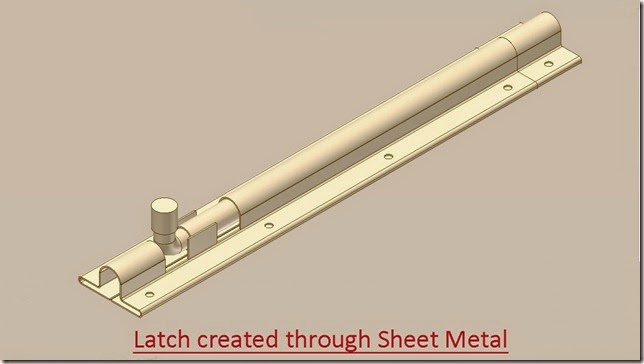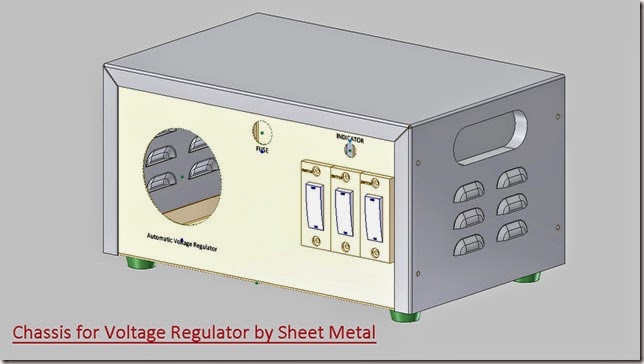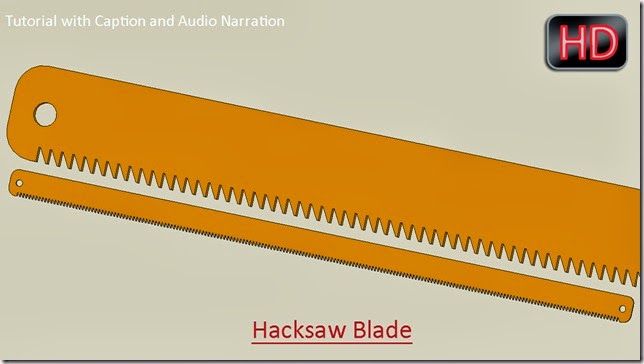
Serial No. 187
Latch created through Sheet Metal-Autodesk Inventor 2013 (with caption and audio narration)
In this video, the creation of an assembly of the latch is shown. First base body parts of the latch will be created using sheet metal template that will utilize Contour Flange, Cut and Mirror tools. Afterwards, a previously created part Sliding rod will be placed in the assembly to complete it.

Click the following link to get the model file: – http://bit.ly/2mRK1tf
Transcription of Video
Latch created through Sheet Metal (Autodesk Inventor)
- Open the ‘Latch Body1’ part file.
- A ‘Base sketch of Latch’ is created in this file.
- Go on the ribbon > Setup panel > click Sheet Metal Defaults icon.
- Uncheck the ‘Use Thickness from Rule’ option to specify the thickness value 3/128 inch manually.
- Go on the ribbon > Create panel > click Contour Flange icon.
- The Profile selection button is active by default in the Contour Flange dialogue box.
- Select the sketch profile.
- A preview of contour flange is visible in the graphics window.
- The thickness of sheet should be inside of the sketch profile.
- Set the value 7 7/8 inch in the Distance field.
- Click OK to create the feature.
- Create a new sketch on the right face of the part.
- Take the project of this face by using Project Geometry tool.
- Convert the projected lines into construction geometry.
- Draw a rectangle with the given dimensions.
- Exit from the sketching environment.
- Go on the ribbon > Modify panel > click Cut icon.
- The sketch profile will be automatically selected.
- Choose ‘All’ option under the Extents field.
- Click OK to apply the cut feature.
- Create a new sketch on the selected face.
- Take the project of this edge and convert it to construction geometry.
- Draw a new line of length 9/16 inch.
- Apply a coincident constraint between midpoint of the line and midpoint of the projected line.
- Finish the 2D Sketch.
- Activate the Contour Flange tool once again.
- Select the line.
- Click more button to expand the dialogue box.
- Set the Width Extents type to ‘Distance’.
- Enter the value 0.35156 inch in Distance field.
- Click OK to create the new flange.
- Go on the ribbon > Pattern panel > click Mirror icon.
- Select the Contour Flange3 in the graphics window as feature to pattern.
- Click Mirror Plane button.
- In the Model browser, pick YZ plane under the Origin folder.
- Click OK to mirror the feature.
- Pick the ‘Corner Round’ tool from Modify Panel.
- And select these four corner edges of the part.
- In the Corner Round dialogue box, set the radius to 1/64 inch.
- Click OK to place the fillet.
- Go on the ribbon > Flat Pattern panel > click Create Flat Pattern icon to generate the flat pattern of the model.
- Activate the ‘Bend Order Annotation’ tool from the marking menu.
- The flat pattern will display numbers that represent the order in which the part would be folded.
- Right click in the graphics window; click OK to finish the bend order annotation command.
- Double-click the ‘Folded Model’ icon at the top of the Model browser to return to the folded model.
- Save the part file and close it.
- Start a new Standard (in) assembly.
- Place the ‘Latch Body1’ part file by using ‘Place Component’ tool.
- Save the assembly with the name ‘Latch’.
- Create a new component using sheet metal template with the name ‘Latch Body2’ in this assembly.
- Select back face of the Latch Body1 to define the sketch plane for the base feature of the new part.
- Open the visibility of ‘Base sketch of Latch’ in the Browser Bar.
- Create a new sketch on this face.
- Take the project of end points of the sketch and centre point of arc.
- Close the visibility of ‘Base sketch of Latch’ in the Browser Bar.
- Recreate the base sketch by joining these projected points.
- Activate the ‘Sheet Metal Defaults’ command.
- Uncheck the ‘Use Thickness from Rule’.
- Set the value 3/128 inch in the Thickness field.
- Activate the ‘Contour Flange’ tool.
- And select the sketch profile.
- Click the ‘Flip Side’ button to set the thickness of sheet inside of the sketch profile.
- Fill the value 7/8 inch in the ‘Distance’ field.
- Click OK to create the new flange.
- Return back to the assembly environment.
- Save the assembly.
- Open the ‘Latch Body2’ part file separately.
- Change the model colour to ‘‘Flaked Reflective - Beige’.
- Check the Flat Pattern and Bend sequence of the folded sheet.
- Place the ‘Sliding rod’ in the Assembly.
- Apply an axis mate between Sliding rod and Latch Body1.
- Double click the ‘Latch Body1’ in browser bar to edit it.
- Start a new sketch on this face of the part.
- Take the project of the face and draw a line connecting the mid points of the projected edges.
- Convert all the sketches into construction geometry.
- Create a circle over this line of 1/8 inch diameter that would be 3/8 inch away from the front face of the model.
- Finish the sketch and start the Cut Tool from modify panel.
- Select All option in the dropdown of Extents and apply the command.
- Create 3 more identical holes at an offset distance of 2 3/8 inch between each hole on the same face of the model by using ‘Rectangular Pattern’ tool.
- Activate Mirror command and duplicate these four holes on the other side of the model.
- Return back to the assembly and double click the ‘Latch Body2’ to edit it.
- Create a hole on this face by applying the same procedure as done in the previous part.
- First create the sketch and then remove the material from the part using Cut feature.
- Duplicate this hole on the other side of the model by using Mirror command.
- The fully developed model will look like this.









